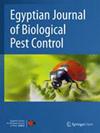芽孢杆菌和假单胞菌防治番茄采后腐病的研究。
IF 2.1
3区 农林科学
Q1 ENTOMOLOGY
引用次数: 0
摘要
摘要背景采后病害对番茄果实在从收获到消费者的处理和储存过程中造成广泛的损失。杀菌剂主要用于防治采后病害。生物防治是一种生态友好的采后病害管理替代策略,在世界范围内正成为一种发展前景。研究了枯草芽孢杆菌、解淀粉芽孢杆菌、树脂假单胞菌、碱性假单胞菌、恶臭假单胞菌和stutzeri假单胞菌6种细菌生物制剂对番茄果实贮藏腐烂病原菌白土曲霉和交替孢霉的抑制作用。结果在体外,大多数生物制剂均能显著降低念珠菌菌丝的生长速度。枯草芽孢杆菌和假链球菌是最优的细菌生物制剂,分别为67.03和72.2%。枯草芽孢杆菌和解淀粉芽孢杆菌的拮抗效果较好。枯草芽孢杆菌和史图氏假单胞菌的发病率和严重程度最低。在番茄果实上施用枯草芽孢杆菌和stutzeri菌的效果最大,分别为90%和87%和91%和89%。同时,枯草芽孢杆菌对交替蒿的抑制作用最大,在两个季节分别达到85%和84%。与对照果实相比,施用生物制剂对两种病原菌均有显著改善,在贮藏期间果实品质(失重、维生素C、TSS和酸度%)均有显著改善。结论枯草芽孢杆菌和史图氏杆菌均可作为番茄果实采后病原菌的潜在生物防治剂。这可能是一种替代杀菌剂的控制策略,为可持续和有机农业服务。本文章由计算机程序翻译,如有差异,请以英文原文为准。
Biological control of postharvest tomato fruit rots using Bacillus spp. and Pseudomonas spp.
Abstract Background Postharvest diseases cause a wide loss to tomato fruits during handling and storing from harvest to consumers. Fungicides are mainly used to control postharvest diseases. Biological control is the eco-friendly substitute strategy used for postharvest diseases management as which becoming promise worldwide. Six bacterial bioagent (i.e., Bacillus subtilis , B. amyloliquefaciens, Pseudomonas resinovorans, P. alcaligenes, P. putida and P. stutzeri ) were tested to suppress both Geotrichum candidum and Alternaria alternata causal agents of tomato fruit rots during storage. Results In vitro, most of bioagents significantly reduced mycelial growth rate of G. candidum . Both of B. subtilis and P. stutzeri were the most superior bacterial bioagents with values 67.03 and 72.2%, respectively. In addition, B. subtilis and B. amyloliquefaciens resulted in the most superior over all antagonists against A. alternata . The lowest percent of disease incidence and severity of G. candidum were obtained by B. subtilis and P. stutzeri . The maximum reduction percent of it on tomato fruits was recorded by applying B. subtilis and P. stutzeri with values (90 and 87%) and (91, 89%) in both seasons, respectively. Also, the highest reduction of A. alternata was obtained by using B. subtilis, which resulted in 85 and 84% in both seasons, respectively. The application of bioagents against both pathogens was significantly improved fruit quality aspects (weight loss, vitamin C, TSS and acidity %) during storage period compared to infected control fruits. Conclusion The findings revealed that both of B. subtilis and P. stutzeri could be potential biological control agents against most postharvest pathogens of tomato fruits. This might be an alternative control strategy instead of fungicides which service the sustainable and organic farming.
求助全文
通过发布文献求助,成功后即可免费获取论文全文。
去求助
来源期刊
CiteScore
4.90
自引率
16.70%
发文量
128
审稿时长
>12 weeks
期刊介绍:
The Egyptian Journal of Biological Pest Control is a periodic scientific journal published by the Egyptian Society for Biological Control of Pests (ESBCP) in collaboration with SpringerNature. The journal aims to publish internationally peer-reviewed, high-quality research articles in the field of biological and integrated pest control (non-chemical control). The journal publishes review articles, original papers, conference reports, book reviews, editorials, laboratory reports, technical notes and short communications.

 求助内容:
求助内容: 应助结果提醒方式:
应助结果提醒方式:


